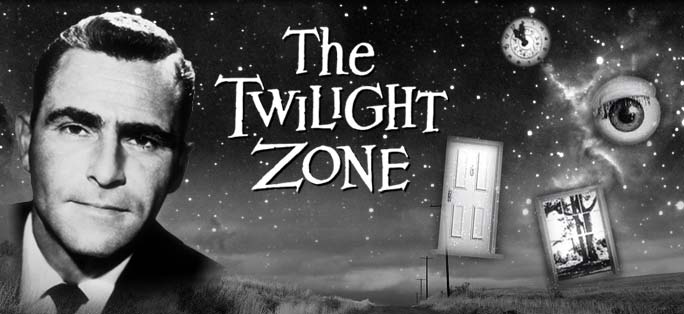 We continue with the final entry in our series of posts by Arlen Schumer exploring The Twilight Zone. (Part 1 can be read here, Part 2 here, and Part 3 here). In Part 4, Schumer continues his exploration of themes of the series, including “the time element,” and “obsolete man”:
We continue with the final entry in our series of posts by Arlen Schumer exploring The Twilight Zone. (Part 1 can be read here, Part 2 here, and Part 3 here). In Part 4, Schumer continues his exploration of themes of the series, including “the time element,” and “obsolete man”:
THE TIME ELEMENT
The time element was a cornerstone of The Twilight Zone, a dimension Serling described as “timeless as infinity.”
“The Time Element” was a precursor to The Twilight Zone, an episode of Desilu Playhouse’s 1958 season that Serling, by then a triple-Emmy Award-winning television playwright, expanded from his own radio play. The hour-long drama, about a man (veteran actor William Bendix) who believes he has gone back in time to the day before the attack on Pearl Harbor, received more mail than any other Playhouse that year, prompting CBS to commission a pilot for what became The Twilight Zone. Once in The Zone, Serling & Co. would continue to explore time and its discontents.
A strong case can be made for Serling’s first-season “Walking Distance” being not only the best time-travel episode of the series, but the best episode of The Twilight Zone, period. Everything about it is literally note-perfect, from Serling’s beautifully- worded script, full of an aching, nostalgic longing for his own childhood…
“I had been living in a dead run And one day I knew I had to come back here I had to come back and get on a merry-go-round
And eat cotton candy
And listen to band concerts I had to stop and breathe and close my eyes and smell and listen.”
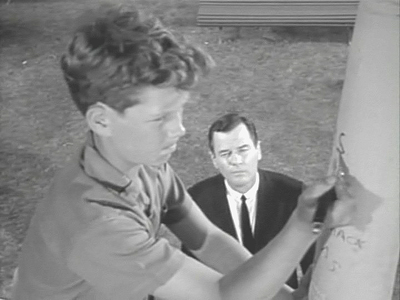 …to Gig Young’s sensitive performance as Serling’s stand-in, photographed for posterity by Twilight Zone Director of Photography George T. Clemens in a series of arresting, character-revealing close-ups; from the subtle direction by Robert Stevens (whose only other Twilight Zone was “Where is Everybody?”), featuring a special effects-free through- the-looking-glass entry back in time and an incredibly stylized carousel climax, to Bernard Herrmann’s truly haunting score, a wistful whine of strings that underscores all the yearning and melancholy associated with the futile quest to recapture youth. “Walking Distance” has subsequently become the benchmark against which all such time-travel television shows and films—Back to the Future, Big, Peggy Sue Gets Married, The Time Traveler’s Wife—are measured. But never bettered.
…to Gig Young’s sensitive performance as Serling’s stand-in, photographed for posterity by Twilight Zone Director of Photography George T. Clemens in a series of arresting, character-revealing close-ups; from the subtle direction by Robert Stevens (whose only other Twilight Zone was “Where is Everybody?”), featuring a special effects-free through- the-looking-glass entry back in time and an incredibly stylized carousel climax, to Bernard Herrmann’s truly haunting score, a wistful whine of strings that underscores all the yearning and melancholy associated with the futile quest to recapture youth. “Walking Distance” has subsequently become the benchmark against which all such time-travel television shows and films—Back to the Future, Big, Peggy Sue Gets Married, The Time Traveler’s Wife—are measured. But never bettered.
“The Trouble With Templeton” was TV writer-producer (Dr. Kildaire, Police Story) E. Jack Neuman’s single Twilight Zone episode—but a classic. Aging stage actor Booth Templeton goes back in time 33 years—“Yesterday and its memories is what he wants,” Serling narrates—and is startled to see his longed-for wife and best friend in a speakeasy actors’ hangout—“And yesterday is what he’ll get,” Serling warns. What follows is one of The Twilight Zone’s most stunningly written, staged, lit and choreographed sequences, in which we find out that everyone in the speakeasy had been “acting” for Templeton, turning what had been a somewhat sentimental exercise (perhaps Neuman’s take on “Walking Distance”?) into something more tragic and true.
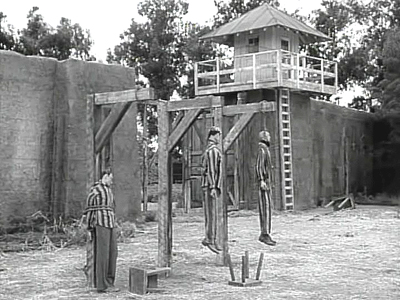 “Escape Clause” is Serling’s contribution to the Faustian soul-selling-to-the-devil genre, in this case in exchange for immortality. As usual, the seller gets less than he bargained for: “Immortality—what’s the good of it? There isn’t any kicks, any excitement!” bemoans David Wayne in a manic performance that, along with the devilish irony of Serling’s ending, makes this the best of the more lighthearted Twilight Zone episodes.
“Escape Clause” is Serling’s contribution to the Faustian soul-selling-to-the-devil genre, in this case in exchange for immortality. As usual, the seller gets less than he bargained for: “Immortality—what’s the good of it? There isn’t any kicks, any excitement!” bemoans David Wayne in a manic performance that, along with the devilish irony of Serling’s ending, makes this the best of the more lighthearted Twilight Zone episodes.
Playing off the ubiquity of the TV westerns that glutted the era’s primetime schedules, Serling’s “A Hundred Yards Over the Rim” transports its protagonist (Cliff Robertson) forward in time to confront the modern frontier. Another example, like “Walking Distance,” of time travel without special effects, as Robertson simply goes over a rim in the desert and through time.
Picking up from the same Death Valley location, “The Rip Van Winkle Caper,” also by Serling, sends a gang of modern gold-stealing outlaws into the future, via suspended animation—technology commonplace in modern science fiction but pretty new to TV audiences in 1961. A classic study in greed, the episode’s grim denouement delivers an ironic lesson in speculating to the last man standing when he finds that, in the future he escaped to, gold is worthless.
The leader of the “Rip Van Winkle” gang, Oscar Beregi, does a second Twilight Zone star turn as a leader of a different gang, a Nazi concentration-camp commandant come to revisit an old haunt, Dachau, in Serling’s polemical “Death’s-Head Revisited.” Airing in November ’61, months after the trial began in Israel of the Holocaust architect Adolf Eichmann (but a month before he was sentenced to death), Serling puts his proxy- Eichmann through trial by Twilight Zone, delivering cathartic release by driving Beregi’s SS Captain insane with hallucinatory visions of the striped-pajama’d, skeletal ghosts of the prisoners he slaughtered years before.
Just like the 1959 episode “Time Enough at Last” (see the theme “Obsolete Man” below) was America’s first televised look at The Day After the bombs drop, “Death’s-Head…” must have been, for many, their first exposure in primetime TV to a Holocaust-themed dramatization (the film version of The Diary of Anne Frank preceded it by two years, the novel The Pawnbroker came out the same year, the Sidney Lumet film of it, starring Rod Steiger, four years away). A prime example of a subject Serling could never have gotten through intact in the ‘50s, but was able to in The Twilight Zone.
Returning to the suspended animation device, “The Long Morrow” is a sequel of sorts to The Twilight Zone’s pilot episode; the isolation tank-testing that the astronaut-in- training hallucinates through in “Where is Everybody?” was intended to prepare him for isolation in deep space—“the long morrow.” This episode’s spaceman embarks on his journey, but not before he lets affairs of the heart cloud his mission, and, as usual in The Twilight Zone, things don’t turn out as planned.
Teetering on the edge of soap opera, this is another beautifully-worded script by Serling, evidenced in this interior monologue describing the state of suspended animation: “It’s not just the long deep sleep that comes when the fear has left…the cold is felt…the slipping away of feeling is noted and succumbed to. The mind functions…time is distorted, jumbled, telescoped, accordioned…but there is a sense of time, even so…” Even bad makeup doesn’t ruin the poignant sorrow of the episode’s climax.
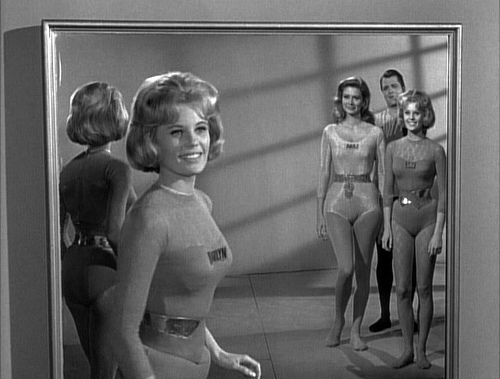 Which, with the age, and gender, of the couples’ roles reversed, is similar in pathos to that of Serling’s “The Trade-Ins,” a cousin to the Twilight Zone episode “Number Twelve Looks Just Like You” (in “Obsolete Man”) about an elderly couple who may have the opportunity to trade in their old bodies for young ones—if they can afford it.
Which, with the age, and gender, of the couples’ roles reversed, is similar in pathos to that of Serling’s “The Trade-Ins,” a cousin to the Twilight Zone episode “Number Twelve Looks Just Like You” (in “Obsolete Man”) about an elderly couple who may have the opportunity to trade in their old bodies for young ones—if they can afford it.
An offbeat addition to “The Time Element” is “An Occurrence at Owl Creek Bridge,” a short French film adaptation of an 1886 Ambrose Bierce short story that won first prize at the 1962 Cannes Film Festival, bought and repackaged as a Twilight Zone episode to bring the final ’63-64 season in under budget. A terse tale of a Civil War Confederate spy’s last moments before—and after—his execution, “An Occurrence…” both hews to the Twilight Zone twist-ending formula and forecasts the 1990 film Jacob’s Ladder, which transferred the setting to the Vietnam War. Exposure as a Twilight Zone episode enabled “An Occurrence…” to win an Oscar in 1964, fitting tribute to one of the many past masters who helped shape Serling’s timeless classic.
OBSOLETE MAN
“I am a human being! I exist! And if I speak one thought aloud, That thought lives!” —Rod Serling, “The Obsolete Man,” 1961
Invariably, when Rod Serling’s name is brought up, The Twilight Zone comes to mind a lot faster and more often than “Requiem for a Heavyweight,” “Patterns,” or any of his other live dramas from the Golden Age of Television; yet many of the themes Serling would later clothe in fantasy and illusion in The Twilight Zone were first explored in those ‘50s teleplays. His most recurring theme—alienation of the individual through bigotry, prejudice, racism, and corporate and technological oppression—was that of the “Obsolete Man.”
Serling’s breakthrough, the Emmy-winning “Patterns” (1955), was a Death of a Salesman-inspired indictment of grey-flannelled Babbitry, with new kid on the corporate block Richard Kiley knocking heads with CEO Everett Sloane over over-the-hill exec Ed Begley, the “obsolete man” in this story.
Serling returned to this milieu years later in The Twilight Zone with “A Stop at Willoughby,” starring James Daly as a harried adman tired of the rat race, pummeled by his boss’ daily harangue, “This is a push business! A push-push-push business! Push and drive! All the way! All the time! Right on down the line!” Daly’s response, feebly admitted to his ultra-materialist shrew of a wife, would become a familiar refrain of the Sixties’ counterculture:
“Some people aren’t built for competition. Or big pretentious houses they can’t afford. Or rich communities they don’t feel comfortable in. Or country clubs they wear around their neck like a badge of status.”
Seeking refuge in “Willoughby,” a turn-of-the-century haven that exists only in his mind, Daly steps off his train—to his death. “Turn on, tune in, and drop
out,” indeed.
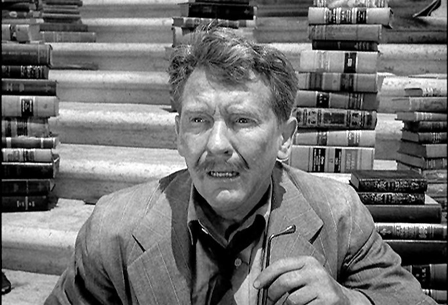 Another sensitive outcast was bookworm Henry Bemis, played by Burgess Meredith, in Serling’s “Time Enough at Last.” His obsession, like Daly’s, for quietude far from the maddening crowd, saves his life when he sequesters himself alone in a bank vault to read, leaving him the sole survivor of a nuclear holocaust (the first fictional visualization of the aftermath of an atomic bomb on American television, and one of the all-time greatest set designs in TV history); it also figures in his downfall. The abrupt, downbeat tone of the ending—Meredith accidentally breaking his glasses, remarkably pessimistic even for Serling (though it was an adapted from a short story by LynnVenable) —accounts for the high esteem this episode is held in today.
Another sensitive outcast was bookworm Henry Bemis, played by Burgess Meredith, in Serling’s “Time Enough at Last.” His obsession, like Daly’s, for quietude far from the maddening crowd, saves his life when he sequesters himself alone in a bank vault to read, leaving him the sole survivor of a nuclear holocaust (the first fictional visualization of the aftermath of an atomic bomb on American television, and one of the all-time greatest set designs in TV history); it also figures in his downfall. The abrupt, downbeat tone of the ending—Meredith accidentally breaking his glasses, remarkably pessimistic even for Serling (though it was an adapted from a short story by LynnVenable) —accounts for the high esteem this episode is held in today.
Happy endings were not usually Twilight Zone’s forte, especially in the works of Serling’s other writers. Like Richard Matheson’s “Steel,” in which newly-minted movie star Lee Marvin (‘62’s The Man Who Shot Liberty Valance) is the titular manager of a robotic prizefighter (the year is 1974; boxing by humans had been abolished in ’68) who must pose as one because of technical difficulties with his mechanical charge. Steel, a former prizefighter, fights against both his robot’s obsolescence and his own, thinking he still has the right stuff to beat “The Maynard Flash,” his android opponent—man versus machine in Matheson’s métier.
Against the vehement advice of his partner trainer, Steel steps into the ring, ghastly and garish in makeup meant to make Marvin’s already grim visage even more mechanical looking—but to no avail, as he is promptly beaten bloody in a bout staged wonderfully well, particularly the almost-humanlike movements of the robot, terrifying in its relentless, Terminator-like onslaught. If there were ever to be prizefighting robots who resembled humans, they’d definitely look much like the way longtime Twilight Zone makeup man William Tuttle conceived them, poker faces of synthetic flesh with eyes as dead and black as a shark’s, riding that perfect line between fantasy and reality that The Twilight Zone, of course, traveled best.
From boxing to billiards we go, to George Clayton Johnson’s “A Game of Pool,” which poses the question: can there be obsolescence in victory as well as defeat? Coincidentally airing less than three weeks after the strikingly similar film The Hustler debuted (9/25/61), with Paul Newman playing the titular hero against Jackie Gleason’s Minnesota Fats, “…Pool” pits Jack Klugman (tied with Burgess Meredith for most Twilight Zone appearances, four), against the great comedian and entertainer Jonathan Winters as “Fats Brown.”
Winters plays Brown with a dignity belying his jovial girth, a reserved resignation borne from years of having to face off against upstarts like Jesse Cardiff (Klugman), just as a wild west gunslinger had to draw against any cock of the walk. Cardiff does finally beat Brown, but finds winning isn’t everything; it is indeed—as he’ll spend the rest of eternity learning—the only thing.
Johnson got the chance to remake this episode for one of the recent Twilight Zone syndicated television incarnations, based on his original script, in which the supernatural ending of the ’61 episode is eliminated, and Cardiff, rather than go to that great pool room in the sky, instead loses to Brown and lives to play again. Like all the Twilight Zone remakes over the years, it is unarguable that the original episode remains, forever, the better.
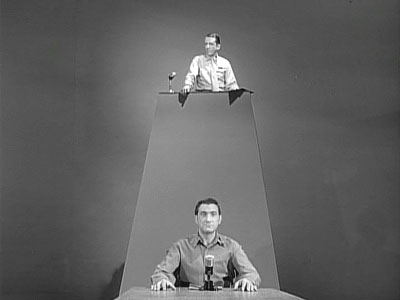 In the tale whose title inspired this theme, “The Obsolete Man” by Serling, Burgess Meredith somewhat reprises his “Time Enough…” Bemis role more seriously, this time as a librarian in the near future, aptly-named Wordsworth, who is condemned to death by the fascistic Chancellor of “The State,” fellow Twilight Zone alum Fritz Weaver (“Third from the Sun”), with the utterly memorable monotone mantra, “YOU-ARE- OBSOLETE.” Against outsized German Expressionist sets, “The Obsolete Man” suggests Kafka’s The Trial (though it predates Orson Welles’ ’62 film adaptation by a year) as might’ve been rewritten by Ayn Rand. If a little strident, the episode’s nevertheless the best expression of Serling’s Orwellian worldview:
In the tale whose title inspired this theme, “The Obsolete Man” by Serling, Burgess Meredith somewhat reprises his “Time Enough…” Bemis role more seriously, this time as a librarian in the near future, aptly-named Wordsworth, who is condemned to death by the fascistic Chancellor of “The State,” fellow Twilight Zone alum Fritz Weaver (“Third from the Sun”), with the utterly memorable monotone mantra, “YOU-ARE- OBSOLETE.” Against outsized German Expressionist sets, “The Obsolete Man” suggests Kafka’s The Trial (though it predates Orson Welles’ ’62 film adaptation by a year) as might’ve been rewritten by Ayn Rand. If a little strident, the episode’s nevertheless the best expression of Serling’s Orwellian worldview:
“History teaches us a great deal. We had predecessors who had the beginnings of the right idea: Hitler, of course; Stalin, too. But their error was not one of excess—it was simply not going far enough. Too many undesirables were left around, and undesirables eventually form a core of resistance. Old people, for example, clutch at the past and won’t accept the new. The sick, the maimed, and the deformed—they fasten onto the healthy body and damage it. So we eliminate them. They can perform no useful function for The State, so we put an end to them.”
Serling makes the political personal when, in a rare mid-episode Twilight Zone twist, Wordsworth turns the tables on The State and forces an eleventh-hour sudden-death stalemate with The Chancellor, live on State-run television—reality TV years ahead of its time.
The climax of “The Obsolete Man,” 1961. Climaxing in the most stagelike mise-en-scene of any Twilight Zone, The State’s two-dozen drones surround the now-obsolete Chancellor, to the sound of the B-side of their “OBSOLETE” chant, a buzzing drone that increases in intensity until, in a bizarre (even for The Twilight Zone) bacchanalia, they pounce on the pleading man and—beat him? Eat him?
The episode’s closing narration, atypically delivered on-camera by Serling, also achieves relevancy in light of subsequent events in global politics, from Tiananmen Square to the fall of the Berlin Wall to the streets of Tehran:
“Any state, any entity, any ideology that fails to recognize the worth, the dignity, the rights of man—that state is obsolete.”
Obsolete, maybe, but until then, still in power, clamping down on all those who refuse to conform—even to standards of physical beauty. The sister episodes “Number Twelve Looks Just Like You” (written by John Tomerlin) and Serling’s “Eye of The Beholder” share this theme.
“Number Twelve…” boasts a number of touches that illuminate much more beyond the confines of the story’s setting, a futuristic hospital where patients cheerfully undergo “The Transformation” into vacuous lookalikes (prefiguring The Stepford Wives, the book and the movie, by a decade): naming the doomed heroine “Marilyn” (Monroe died a year and a half earlier) and her girlfriend, a proto-Valley Girl, “Val” (who recites the State anthem, “Life is pretty/Life is fun/I am all/And all is one!”); Val’s recreational drug of choice, “Instant Smile”; the casting of the real-life Supermodel of the day (1963), Suzy Parker, as Val’s mother; the suggestion, when mom’s maid is condescended to—despite her same Parker supermodel looks—that class differences will always trump physical differences; the original mid-program commercial for “Thrill” dish detergent that (coincidentally?) offers women “a new pair of hands”; and Serling’s concluding, clairvoyant voiceover: “Portrait of a young lady in love—with herself. Improbable? Perhaps. But in an age of plastic surgery, body building and an infinity of cosmetics, let us hesitate to say impossible.”
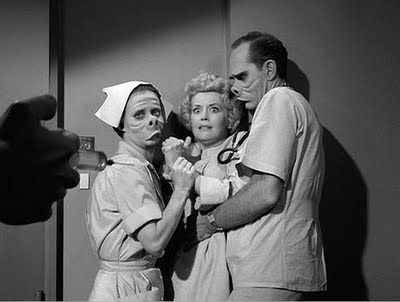 In “Eye of The Beholder,” Serling takes the age-old adage about beauty and gives it such a thorough Twilight Zone treatment that it remains the series’ quintessential episode. When it was originally telecast in 1960, chances are the bandaged Janet Tyler (another strong Serling female lead), considered hideously ugly and threatened with segregation with those of “her own kind” if her (eleventh!) plastic surgery failed, was seen as Serling’s poster child for the burgeoning Civil Rights Movement; but since then, the generic hospital setting and talk of quarantining those “similarly afflicted” reeks of AIDS-era ignorance, while the rant by the “Leader” about conforming to society’s norms not only parallels Serling’s own struggles with the censors, but foretells the culture wars waged ever since:
In “Eye of The Beholder,” Serling takes the age-old adage about beauty and gives it such a thorough Twilight Zone treatment that it remains the series’ quintessential episode. When it was originally telecast in 1960, chances are the bandaged Janet Tyler (another strong Serling female lead), considered hideously ugly and threatened with segregation with those of “her own kind” if her (eleventh!) plastic surgery failed, was seen as Serling’s poster child for the burgeoning Civil Rights Movement; but since then, the generic hospital setting and talk of quarantining those “similarly afflicted” reeks of AIDS-era ignorance, while the rant by the “Leader” about conforming to society’s norms not only parallels Serling’s own struggles with the censors, but foretells the culture wars waged ever since:
“It is essential in this society that we not only have a norm, but that we conform to that norm! Conformity we must worship and hold sacred! Conformity is the key to survival!”
The script is a hallmark of Serling’s style: strong on theme, poetic dialogue, morality, and suspense, capped by a truly unforgettable ending. The deft direction by Douglas Heyes and stunning camerawork by George T. Clemens, meant to obscure the doctors’ and nurses’ pig- like faces (the masterworks of William Tuttle) until the end, are nothing if not artistically audacious. And Maxine Stuart, playing the bandaged Tyler (the revealed Tyler was Donna Douglas, soon to be Elly May Clampett on The Beverly Hillbillies), had to act with her hand gestures and voice only—and created a performance for the ages.
“Eye of the Beholder,” Serling’s message of tolerance and compassion, finally reveals that we are all Janet Tylers beneath our bandages, faceless and invisible to a society that would prefer nothing more than to render our individuality…obsolete.
The Twilight Zone is a legacy that continues to teach, entertain, and inspire; it is a measure of that legacy that Rod Serling was able to surmount the obstacles inherent in a commercial medium like television to touch more peoples’ imaginations with more ideas of lasting impact than any American (television?) writer of our time.
“As long as people talk about you, you’re not really dead As long as they speak your name, you continue A legend doesn’t die just because the man does”
—George Clayton Johnson, “A Game of Pool,” 1961.
Arlen Schumer wrote and designed Visions From The Twilight Zone, the only coffee table art book about the series, and continues to present a multimedia show based on the book to universities and cultural institutions around the country, including The 2008 Rod Serling Conference at Ithaca University, and the 2009 New York Comic Convention, where he also presented his mini-marathon, “The Five Themes of The Twilight Zone.” He presented his new show, “The Twilight Zone Forever,” at The New York Times’ TimesCenter in New York on the exact 50th Anniversary of The Twilight Zone’s debut, October 2, 2009. On November 11 Schumer will make a presentation in connection with a screening the 50th anniversary of “The Eye of the Beholder” episode at the prestigious Tribeca Cinema. Tickets can be purchased here.
The Twilight Zone season 1 & season 2 are available on Blu-ray DVD at the TheoFantastique Store.





One Response to “THE TWILIGHT ZONE FOREVER: On the release of Rod Serling’s The Twilight Zone Seasons 1 & 2 on Blu-ray (Part 4)”